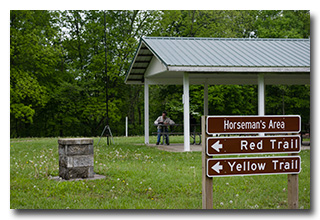
by William Eric McFadden
From the park's website:
-
Located in southeast Ohio, quiet and remote Burr Oak State Park has a rustic country charm in its 2,593-acre scenery of wooded hills and valley farms. As one of Ohio's resort parks, Burr Oak offers a wide array of overnight accommodations with its lodge, cabins and campground. Burr Oak blends modern conveniences with the wilderness spirit of Ohio.
Pictures
- "Welcome to Burr Oak State Park"
- Eric's station; photo by Miles McFadden
- Eric operating; photo by Miles McFadden
- Mindy-dog; photo by Miles McFadden
- Theo-dog; photo by Miles McFadden
Description
 One member of the Southeast Ohio Radio Adventure Team succeeded in
performing a valid activation of Burr Oak State Park, K-1939, in Ohio as part of the the
Parks on the Air (POTA; link) program. Eric McFadden, WD8RIF,
visited Burr Oak with his wife, Vickie (KC8MAJ); his son, Miles (KD8KNC); and their two small dogs, Theo and
Mindy on an overcast but pleasant spring day.
One member of the Southeast Ohio Radio Adventure Team succeeded in
performing a valid activation of Burr Oak State Park, K-1939, in Ohio as part of the the
Parks on the Air (POTA; link) program. Eric McFadden, WD8RIF,
visited Burr Oak with his wife, Vickie (KC8MAJ); his son, Miles (KD8KNC); and their two small dogs, Theo and
Mindy on an overcast but pleasant spring day.
Eric and his family arrived at Burr Oak about 1920 UTC, explored a bit to find a place to set up, and finally selected the picnic pavilion at the Horseman's Area which, fortunately, was free of horses and horsemen at that particular time. Because of the challenge in making QSOs at Wayne National Forest earlier in the day using the 58' end-fed wire antenna, Eric chose to return to his tried-and-true 28½' wire vertical. With practiced ease, Eric and Miles quickly set up the vertical on the MFJ-1910 33' fiberglass mast and Eric set up his KX3 on a picnic table inside the pavilion. Eric was on the air by 1945 UTC.
Eric began operations on 40m and, finding a frequency clear of New England QSO Party (NEQP) activity, becan calling "CQ POTA". In eleven minutes, five QSOs were made. Changing to hunt-and-pounce, Eric began working NEQP stations and in eighteen minutes seven QSOs were made.
Switching to 20m, a single QSO resulted from Eric's calls of "CQ POTA".
Returning to 40m, another seven NEQP stations were worked in eleven minutes.
All Eric's QSOs were made at the 5-watt level.
Eric found QSOs very easy to make using the 28½' wire vertical; indeed, it felt like the proverbial "shooting fish in a barrel". It took Eric just under an hour to make a full twenty QSOs. He was able to work almost every NEQP station he tried on just one or two calls. It was clear to Eric that the 28½' wire vertical is superior to the 58' end-fed wire he has recently been testing, at least on 40m.
Eric also submitted his log to the World Wide Flora and Fauna in Amateur Radio (WWFF; link) program although he didn't make enough QSOs to to achieve a valid activation within the program which requires 44 QSOs be made. However, the WWFF program allows these 44 QSOs be made over any number of visits so a valid activation within WWFF is still possible if subsequent visits to the park are made.
(return)

